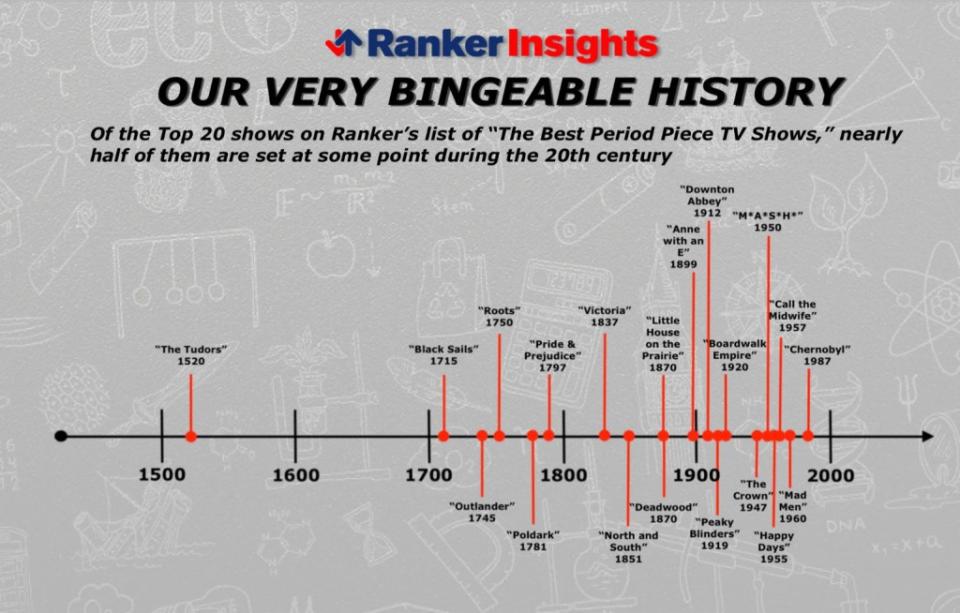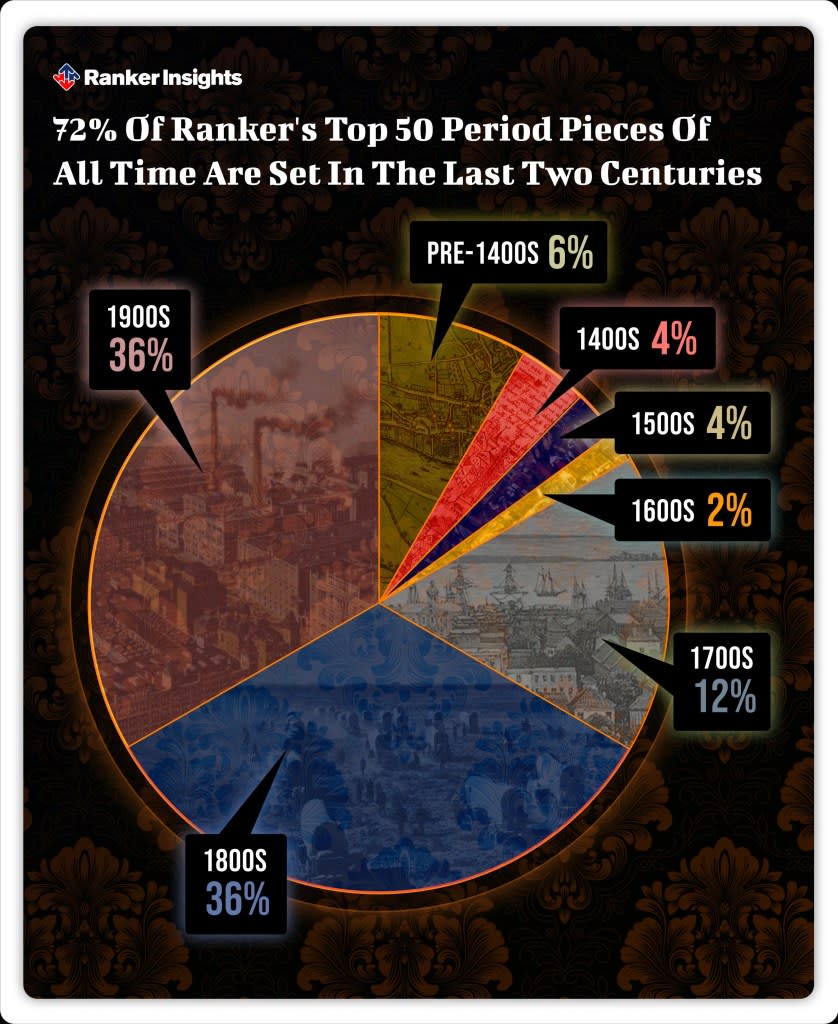Do Fans of Historical TV Shows Favor a Particular Time Period? | Charts
“The Gilded Age,” Julian Fellowes’ critically lauded follow-up to “Downton Abbey,” has returned for a second season on HBO. Although “The Gilded Age” slightly alters the formula that made “Downton Abbey” so popular, swapping out turn-of-the-century England for a rapidly developing America in the late 1800s, it takes place just a few decades before its predecessor. Does that just reflect Fellowes’ fascination with a particular period? Or should we take it as a sign from a master of the genre that this is the ideal setting for a period piece TV show?
Inspired by “The Gilded Age” Season 2, we took a look at Ranker’s list of the 101 Best Period Piece TV Shows (24K votes) to see if readers’ favorite period dramas and comedies happen to center around one period in particular. We also examined the fanbases for some of the most popular shows to see if fans tend to love shows from one particular era or if they just happen to like television that’s set in the past, no matter what era.
Which Period Is Best?
To get a sense of when the highest-ranked shows on this list are set in relation to our own time, Ranker Insights arranged the first 20 titles along a timeline. For each show, we used the year in which the show is set at the beginning — for example, “Mad Men” is listed as being set in 1960.

As you can see, the shows become packed more and more densely together as we get closer to the present. “The Tudors,” ranked #12 overall in popularity according to Ranker Insights, is the only show in the Top 20 to take place between the 15th and 18th centuries. Meanwhile, nine shows — nearly half the Top 20 — are set between the year 1900 and the year 2000, including #1 ranked series “Downton Abbey.” The 18th and 19th centuries each have five series from the Top 20, with the 1700s claiming two of the most iconic miniseries in television history: “Roots” and the BBC’s 1995 production of “Pride and Prejudice.”
But would this trend hold if we looked at a larger sample of movies? When we looked at the Top 50 shows on the Ranker Insights list, we found that the 19th century benefited most, tying with the 20th century for the largest number of Top 50 period pieces. But otherwise, the results still suggest that shows set in more recent periods had an easier time being voted up into the Top 50 than those set in earlier historical eras. The 19th and 20th centuries are tied for the most popular period piece setting, with a combined 72% of these 50 shows taking place between 1800 and 2000.

But Are Viewers Really Drawn to Particular Periods?
These findings pose an interesting “chicken or the egg” question: do audiences love shows about the last two centuries, or is Hollywood just better at making them? Put another way, are period piece fans a group of history buffs more drawn to the recent past than our more distant histories? Or are they simply fans of great TV, with the entertainment industry churning out more quality content from the 19th and 20th centuries than any other period?
There’s some support for the idea that 19th and 20th century period pieces are just more popular using Ranker Insights. For example, fans of “Poldark,” a drama whose story begins in 1781, are more likely to also love “Downton Abbey” (1912) and “Victoria” (1837) than any other shows. Similarly, fans of “Wolf Hall” (1500) are more likely to also enjoy “Pride and Prejudice” (1797) than any other series.
But there’s far more evidence to suggest that fans of period dramas and comedies simply love good TV, regardless of when its action takes place. According to Ranker Insights data, “Peaky Blinders” (1912) fans are seven times more likely to enjoy other shows set in the 20th century, including “Boardwalk Empire” (1920) and “Narcos” (late 1970s), but they’re also eight times more likely to love “Taboo,” set nearly a century earlier than their favorite series. Those who love “Hell on Wheels” (1865) are about as likely to also enjoy “Black Sails” (1715) and “Turn: Washington’s Spies” (1776) as they are “Deadwood” (1870) and “Vikings” (793).
There are certainly some subgroups within the larger period piece fanbase. The four other shows most likely to also be enjoyed by fans of “The White Queen” (1464), for instance, are “The White Princess” (1485), “The Tudors” (1520), “The Spanish Princess” (1506) and “The Borgias” (1492). But even these fans with a special interest in a particular historical milieu are still very much open to shows from another era, as “White Queen” fans are six times more likely to love “The Crown” (1947) and four times more likely to enjoy “Call the Midwife” (1957).
As for fans of “The Gilded Age,” they’re more likely to enjoy Netflix’s “Bridgerton” (1813) than sister series “Downton Abbey.”
As a broad genre with plenty of variations, period pieces have a diverse set of fans drawn to all manner of different stories and settings. The only hard and fast rule that defines the period piece is that we’re producing more great examples of it than ever.
Ryan Mach is a content marketing manager at Ranker, a WrapPRO partner. Visit Ranker Insights for more unique information about any audience or to contact us for more information.
For more from WrapPRO partners, visit the Data and Analysis Hub.
The post Do Fans of Historical TV Shows Favor a Particular Time Period? | Charts appeared first on TheWrap.

 Yahoo News
Yahoo News 
